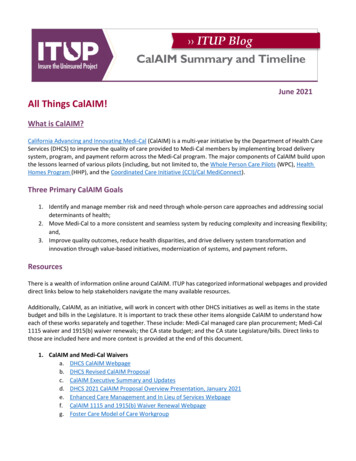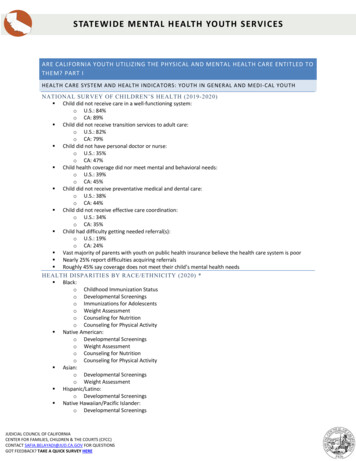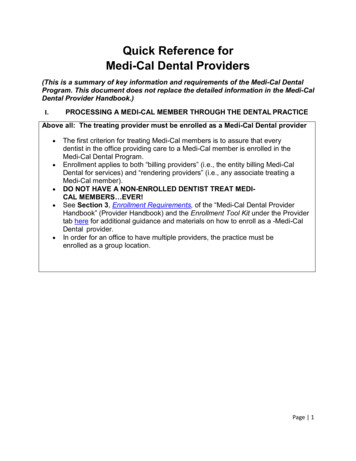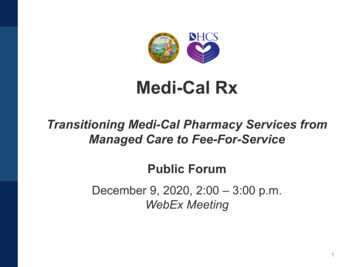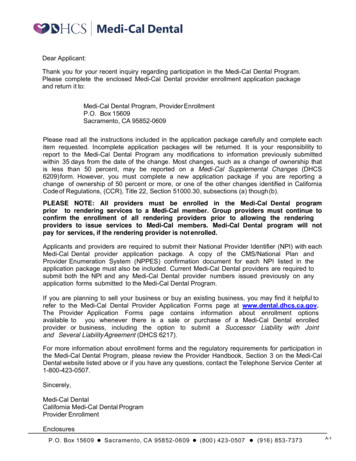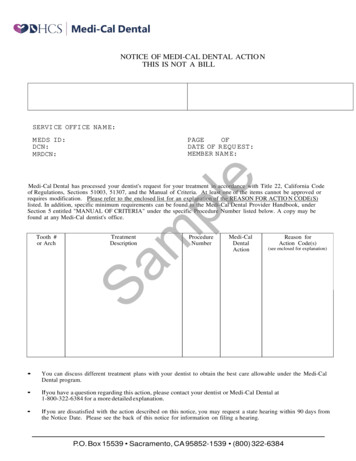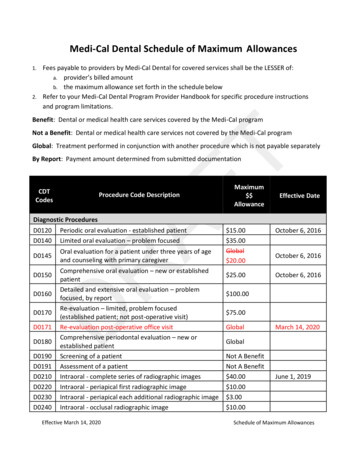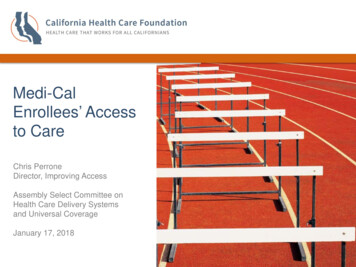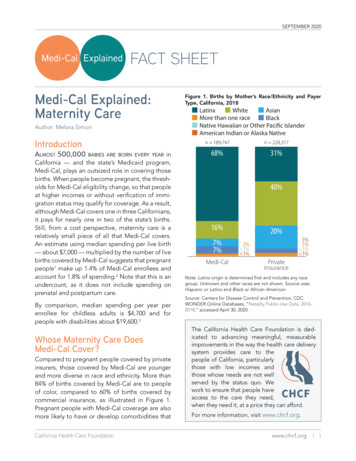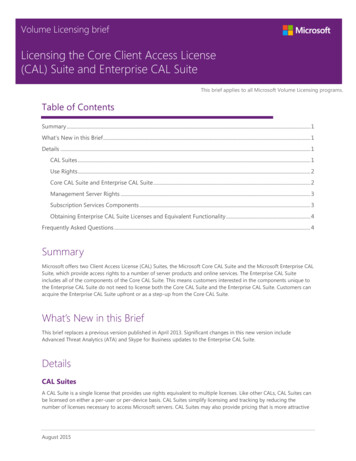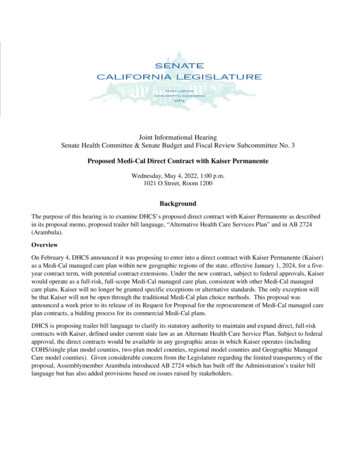
Transcription
Joint Informational HearingSenate Health Committee & Senate Budget and Fiscal Review Subcommittee No. 3Proposed Medi-Cal Direct Contract with Kaiser PermanenteWednesday, May 4, 2022, 1:00 p.m.1021 O Street, Room 1200BackgroundThe purpose of this hearing is to examine DHCS’s proposed direct contract with Kaiser Permanente as describedin its proposal memo, proposed trailer bill language, “Alternative Health Care Services Plan” and in AB 2724(Arambula).OverviewOn February 4, DHCS announced it was proposing to enter into a direct contract with Kaiser Permanente (Kaiser)as a Medi-Cal managed care plan within new geographic regions of the state, effective January 1, 2024, for a fiveyear contract term, with potential contract extensions. Under the new contract, subject to federal approvals, Kaiserwould operate as a full-risk, full-scope Medi-Cal managed care plan, consistent with other Medi-Cal managedcare plans. Kaiser will no longer be granted specific exceptions or alternative standards. The only exception willbe that Kaiser will not be open through the traditional Medi-Cal plan choice methods. This proposal wasannounced a week prior to its release of its Request for Proposal for the reprocurement of Medi-Cal managed careplan contracts, a bidding process for its commercial Medi-Cal plans.DHCS is proposing trailer bill language to clarify its statutory authority to maintain and expand direct, full-riskcontracts with Kaiser, defined under current state law as an Alternate Health Care Service Plan. Subject to federalapproval, the direct contracts would be available in any geographic areas in which Kaiser operates (includingCOHS/single plan model counties, two-plan model counties, regional model counties and Geographic ManagedCare model counties). Given considerable concern from the Legislature regarding the limited transparency of theproposal, Assemblymember Arambula introduced AB 2724 which has built off the Administration’s trailer billlanguage but has also added provisions based on issues raised by stakeholders.
Medi-Cal managed care plan modelsThe managed care model of health care service delivery in California began in the 1970s with legislation thatculminated in passage of the Knox Keene Health Care Service Plan Act of 1975 (Knox-Keene Act). Beginning in1981, the state began licensing different models of managed care delivery for Medi-Cal beneficiaries in differentcounties. Today, over 12 million Medi-Cal beneficiaries are enrolled in a Medi-Cal MCP and receive servicesthrough one of six managed care models. The six models of managed care in the Medi-Cal program are:1) County Organized Health Systems. In 1982, the Legislature authorized the creation of three countyorganized health systems (COHS), which are county-administered Medi-Cal managed care plans. SantaBarbara and San Mateo Counties were the first COHS plans to enroll beneficiaries (a COHS was planned inMonterey, but was never implemented), while Congress approved three additional COHS (Santa Cruz,Solano, and Orange) counties in 1990. The authorization for COHS requires that they be an independent,public entity and that they meet the regulatory requirements of the state’s Knox-Keene Act. However, theyneed not obtain a license under the Knox-Keene Act, as they are specifically exempted. There are currentlytwenty-two counties in the COHS model: Del Norte, Humboldt, Lake, Lassen, Marin, Mendocino, Merced,Modoc, Monterey, Napa, Orange, San Luis Obispo, Santa Barbara, Santa Cruz, San Mateo, Shasta, Siskiyou,Solano, Sonoma, Trinity, Ventura, and Yolo. Eight of these counties (Del Norte, Humboldt, Lake, Lassen,Modoc, Shasta, Siskiyou, and Trinity) were part of the expansion of Medi-Cal to rural counties implementedin 2012. Beneficiaries in these counties receive services through Partnership Health Plan of California. InMarch, 2022, there were just under 2.5 million enrollees in COHS plans.2) Geographic Managed Care. In 1992, DHCS designated Sacramento County as a geographic managed care(GMC) county, which allowed many plans to operate within the county to provide services to Medi-Calbeneficiaries. In 1998, San Diego also became a GMC county, and both counties currently contract withseveral commercial health plans with the goal of providing more choice to beneficiaries. As these plans arecommercial plans, they are required to be licensed under the Knox-Keene Act. Sacramento and San Diegoremain the only two GMC counties in the state. In March 2022, there were just under 1.4 million enrollees inGMC plans.3) Two Plan Model. In 1995, as part of a significant expansion of Medi-Cal managed care, twelve countieswere designated to participate in a new Two Plan Model for managed care delivery. Under this model, onecounty-developed plan, a local initiative, offers services alongside a commercial plan. Both plans are requiredto be licensed under the Knox-Keene Act. There are currently fourteen Two Plan Model counties: Alameda,Contra Costa, Fresno, Kern, Kings, Los Angeles, Madera, Riverside, San Bernardino, San Francisco, SanJoaquin, Santa Clara, Stanislaus, and Tulare. Los Angeles’ local initiative, L.A. Care, subcontracts withseveral other managed care plans to provide services to Medi-Cal beneficiaries. In March 2022, there werejust under 8 million managed care enrollees in the Two Plan models, with 6 million of those enrollees in thelocal initiative plan, though as mentioned, many of those enrollees in Los Angeles receive services through asubcontracted commercial plan.4) Regional Model. AB 1467 (Committee on Budget, Chapter 23, Statutes of 2012) authorized the expansion ofMedi-Cal managed care into 28 rural counties not previously operating managed care plans. These countiesphased in between November 2013 and December 2014. Eight counties transitioned into the COHS model,while 18 counties transitioned into a new regional model, including: Alpine, Amador, Butte, Calaveras,Colusa, El Dorado, Glenn, Inyo, Mariposa, Mono, Nevada, Placer, Plumas, Sierra, Sutter, Tehama,Tuolumne, and Yuba. Beneficiaries in these counties receive services through either Anthem Blue Cross orCalifornia Health and Wellness. In March 2022, there were approximately 354,000 enrollees in regionalmodel plans.
5) Imperial Model. Imperial County was one of the 28 county counties in the rural county expansion. Ratherthan join the 18 counties under the regional model or transition into a COHS, Imperial County established aLocal Health Authority Commission (Commission) that provides oversight over the Medi-Cal managed careprogram in the county. Beneficiaries in the Imperial County receive services through two commercial MediCal MCPs. The Commission selects one commercial Medi-Cal MCP, which, in addition to the contract withDHCS, must also meet local contract provisions established by the Commission, and DHCS selects the other.In March 2022, there were approximately 87,000 enrollees in Imperial model plans.6) San Benito Model. The rural county expansion also brought managed care to San Benito County. Unlike therest of the state, beneficiaries in San Benito County receive services through either Anthem Blue Cross, orfee-for-service Medi-Cal. In March 2022, there were just over 10,400 enrollees in San Benito model plans.Current role of Kaiser in Medi-Cal managed careCurrently, there are close to 900,000 Medi-Cal enrollees in Kaiser, which participates as a subcontractor with 12local Medi-Cal managed care plans (in 17 counties) and has a direct contract in five counties, inclusive of the twoGeographic Managed Care (GMC) counties and three of the regional model counties. Kaiser participates in MediCal primarily through a continuity of care model, serving Medi-Cal beneficiaries who had Kaiser coveragethrough a commercial plan or Medicare, or who have family members with Kaiser coverage. Medi-Cal enrolleeswithout a pre-existing linkage to Kaiser cannot choose or are not defaulted into Kaiser. The following chart showsin the enrollment as reported by Kaiser in January 2022:Current Kaiser Medi-Cal EnrollmentCountyPlan ModelDirectEnrollmentEnrollment% of Medi-CalEnrollment ional,changing toCOHS11,28419.11%62,0547.27%2,8698.24%2102.82%San DiegoEl DoradoAmadorGMCRegional,changing to OHS7,87317.38%Alameda2-plan, changingto single44,72712.08%
15.94%Contra Costa2-plan, changingto single40,474YoloCOHS6,41510.96%Santa Clara2-plan34,2469.46%San Bernardino2-plan77,1829.32%San MateoCOHS11,5639.31%Riverside2-plan67,9798.13%San Francisco2-plan14,2818.05%Los Angeles2-plan243,6737.22%OrangeCOHS55,3846.43%San raCOHS6,6752.90%The plans that Kaiser subcontracts with do not pass through the entire premium they receive to Kaiser. Kaiserdescribes this as an administrative fee, while local plans argue it covers the cost of overseeing the contract withKaiser and for benefits they provide that Kaiser does not. The amounts are propriety and determined via contractbetween Kaiser and each Local Initiative and COHS and vary by plan, but DHCS indicates they average 5%.DHCS’s managed care performance dashboard measures the number of primary care physicians per 2,000 planenrollees and all physicians per 1,200 plan enrollees. Kaiser had the second highest number of primary carephysicians compared to other plans, and the third highest physicians per 1,200 members compared to other plans.Medi-Cal managed care plan reprocurementIn 2021, DHCS began a statewide procurement process of commercial Medi-Cal managed care plans for the newmanaged care contract effective January 1, 2024. Prior to the actual plan reprocurement, DHCS allowed countiesto submit a letter of intent if they wanted to switch plan models. DHCS also announced it would limit the numberof prime plans in GMC model counties. In order for Kaiser to participate in the GMC model, it would have toagree to a significant enrollment increase. DHCS provided conditional approval to 17 counties to change the typeof managed care plan model in which they participate as demonstrated in the graphic below:
On February 9, 2022, DHCS released a Request for Proposal (RFP) for its commercial managed care plancontracts. While the RFP is only for commercial plans, DHCS indicates the updated contract released with theRFP will be executed with all Medi-Cal managed care plans, including local initiatives and County OrganizedHealth Systems, as of January 1, 2024. Plans turned in their proposals by April 11 and DHCS expects toannounce the awarded contracts in August of this year, giving plans the rest of 2022 and 2023 to prepare for thenew contracts starting January 1, 2024. The chart below shows which counties are involved in reprocurement andunder what models:New contract requirements in reprocurementAccording to DHCS, the restructured managed care contract that is the subject of reprocurement reflects DHCS’intention to hold all plan partners and their subcontractors more accountable for high-quality, accessible, andcomprehensive care across all settings and levels of care, reducing health disparities, and improving healthoutcomes. Managed care plans will now be required to routinely and publicly report on financial performance
information as well as access, quality improvement, and health equity activities. They will be expected to exceedquality improvement benchmarks or face sanctions and potentially be required to surrender a portion of theirprofits. Plan payment will be linked to quality and equity, and plans will be required to comply with new providershared risk, savings and incentive arrangements. Building on proposed changes for 2023 to base capitationpayment rates on performance on certain high-priority quality and health equity outcome measures, sucharrangements include incentive payment arrangements that reward providers for high or improved performance onselected measures or benchmarks. Plans will report on what proportion of their spending is on primary andintegrated care and tied to alternative primary care payment models. Additionally, plans will be held accountablefor the quality of care at all levels of delegation, and for the first time, the contract mandates that plans reportinformation on delegated functions. This will include justification for the use of delegated entities andsubcontractors to ensure that members’ experiences and outcomes are drivers of these decisions.Plans will be required to partner with local agencies (e.g., local health departments, county behavioral healthplans, continuums of care, community-based organizations) to ensure that they understand and meet communityneeds. Plans will also be required to facilitate warm hand-offs and closed-loop referrals of members to communityresources and follow-up to ensure services are rendered. Plans and their fully delegated subcontractors withpositive net income will also be required to allocate 5 to 7.5 percent of these profits (depending on the level oftheir profit) to local community activities that develop community infrastructure to support Medi-Cal members.Plans will be newly required to provide medically necessary health and behavioral health services in schools andother settings (i.e., at home and in the community) and implement interventions by school-affiliated providers thatincrease access to preventive, early intervention, and behavioral health services. For the first time, plans will berequired to train providers on Early and Periodic Screening, Diagnostic, and Treatment Services. They will alsobe required to expand access to evidence-based behavioral health services focused on earlier identification andengagement in treatment for children, youth, and adults and integrated with physical health care, includingestablishment of No Wrong Door policies to support access to diagnoses and treatment. Plans will implement andsupport CalAIM initiatives to improve the quality of life and health outcomes of member populations byestablishing broad delivery system, program, and payment reform across Medi-Cal.With regards to quality and addressing social drivers of health, plans and their subcontractors are expected toachieve National Committee for Quality Assurance (NCQA) Health Plan Accreditation by 2026. Plans will berequired to identify physical and behavioral health disparities and inequities in access, utilization, and outcomesby race, ethnicity, language (including limited English proficiency), and sexual orientation, and to have focusedefforts to improve health outcomes within the most impacted groups and communities. They will also be requiredto have a Chief Health Equity Officer and achieve NCQA Health Equity Accreditation, a new standards programfocused on advancing the delivery of more equitable and culturally and linguistically appropriate services acrossmember populations. Plans are also required to implement new population health management and caremanagement strategies to address the unmet social needs of members, such as food security and housing, anddocument members’ needs and services.DHCS’s proposed direct contract with KaiserIn this context, DHCS proposes trailer bill language to allow it to enter into a direct contract with KaiserPermanente as a Medi-Cal managed care plan within new geographic regions of the state, effective January 1,2024, for a five year contract term, with the potential for contract extensions. Under the new contract, Kaiserwould operate as a full-risk, full-scope Medi-Cal managed care plan, consistent with other Medi-Cal managedcare plans and without specific exceptions or alternative standards. This includes the additional contractrequirements described above. However, Kaiser would not be open to beneficiaries through the traditional MediCal plan choice methods, but would only be available to existing Kaiser members in both Medi-Cal andcommercial lines of business, members with family linkage, dually eligible Medicare and Medi-Cal enrollees,
foster and former foster youth, and via default enrollment for Medi-Cal beneficiaries that have not chosen a plan.Kaiser would also commit to growth of its Medi-Cal members by 25 percent by the end of the five year term.DHCS’s rationale for the direct contract is as follows. In 2021, DHCS announced it would limit the number ofprime plans in GMC model counties. However, due to limitations in Kaiser’s integrated model, physical capacityas well as fixed geographic locations, Kaiser is not in a position to be listed on Medi-Cal enrollment choice formsfor all Medi-Cal beneficiaries. DHCS states if Kaiser is unable to participate in the RFP due to its network’sphysical capacity, the Medi-Cal program would lose its highest quality plan, its integrated model and clinicalexpertise.In addition Kaiser’s enrollees in at least the GMC and direct contract counties (Sacramento, San Diego, Amador,El Dorado, and Placer) would need to change health plans. Finally, DHCS states that growth commitment fromKaiser in the DHCS proposal will mean that Medi-Cal growth will be at a faster rate than Kaiser’s projectedgrowth for commercial (CalPERS, Covered CA, etc.) and Medicare. While Kaiser is open to all comers on theselines of business, it is at a manageable rate that aligns with their available capacity. If Kaiser were to take allcomers in Medi-Cal, the growth rate would far outpace their physical capacity, especially since DHCS’ defaultalgorithm favors quality and Kaiser far exceeds quality scores in all counties it participates in. DHCS statesKaiser consistently scores above 90% in the Aggregated Quality Factor Score, which is a quality score thataccounts for plan performance on DHCS-selected Healthcare Effectiveness Data and Information Set indicators.In comparison, the weighted average of other MCMC plans is 65%. Further, in 41 of 48 quality measures Kaiser(either Northern California and/or Southern California) exceed the weighted average for all MCMC plan and in37/48 measures significantly better than the weighted average.DHCS also points to the following arrangements of this proposal: Kaiser will implement CalAIM Enhanced Care Management (ECM) and Community Supports in a mannerconsistent with other Medi-Cal managed care plans. Kaiser will leverage more community presence withother providers (e.g., county departments, public hospitals and health systems, and community health centers)and not solely provide all ECM and Community Supports internally. Kaiser will also commit to broad uptakeof Community Supports, consistent with other Medi-Cal managed care plans and will implement at least thesame number of Community Supports as other Medi-Cal managed care plans in the area. Kaiser will support FQHCs across the state to implement a robust portfolio of population health managementand practice transformation solutions to augment clinical outcomes for patients cared for in this vitalcommunity-based system. This bolsters the strengths of two systems: The breadth of community presence andcultural and equity excellence of the FQHCs and the practice transformation and approach to quality care ofKaiser. DHCS and Kaiser will identify the highest need specialties and geographic areas where Kaiser will provide,by Kaiser physicians, a limited number of in person, ambulatory based, outpatient specialty care visits, andassociated needs such as diagnostic testing and outpatient procedures for non-Kaiser members. These servicesmay be provided at locations other than Kaiser facilities (for example at FQHCs). Similar to above, thiswould leverage Kaiser’s clinical expertise and integrated model to support underserved areas and would testout models and partnerships to deliver specialty care.DHCS’s proposed trailer bill languageDHCS proposed trailer bill language includes some of these provisions, largely focusing on which beneficiariescould enroll in Kaiser. The language would authorize DHCS to enter into one or more comprehensive riskcontracts with an alternate health care service plan (AHCSP) to serve as a primary Medi-Cal managed care planfor specified eligible beneficiaries in geographic regions designated by DHCS. An AHCSP is defined as a
nonprofit health care service plan with at least 4,000,000 enrollees statewide that owns or operates pharmaciesand provides professional medical services to enrollees in specific geographic regions through an exclusivecontract with a single medical group in each specific geographic region in which it is licensed.Eligible beneficiaries include:a) A beneficiary who was previously enrolled in the AHCSP as either their primary Medi-Cal managed care planor who was assigned to the AHCSP as a subcontractor of their primary Medi-Cal plan on or before December31, 2023;b) An existing member of the AHCSP who is transitioning into Medi-Cal managed care;c) A beneficiary who was a member of the AHCSP at any time during the 12 months immediately preceding theeffective date of the beneficiary’s Medi-Cal eligibility;d) A beneficiary with an AHSCP family linkage. Family linkage includes when a beneficiary’s parent, guardian,minor child, or minor sibling is enrolled in or has been enrolled in the AHCSP at any time during the 12months prior to the effective date of the beneficiary’s Medi-Cal eligibility;e) A dual eligible beneficiary residing in a geographic region approved by DHCS; and,f) A beneficiary eligible on the basis of their receipt of services through a state foster care program or is aformer foster youth, as defined, in a region approved by DHCS.The trailer bill language authorizes DHCS to contract with an AHCSP as a Medi-Cal managed care plan in anygeographic region of the state for which federal approval is available. The language authorizes DHCS toimplement those provisions by means of plan letters or other similar instructions and requires DHCS to seekfederal approval to implement those provisions and would condition the implementation of the provisions on thatfederal approval.AB 2724 additionsAB 2724 starts with the Administration’s trailer bill and further refines it based on issues raised in DHCS’s ownproposal and issues raised by stakeholders. It further refines who has family linkage as:a)b)c)d)A beneficiary’s spouse or domestic partner;A beneficiary’s dependent child or stepchild under 26 years of age;A beneficiary’s foster child or stepchild under 26 years of age;A beneficiary’s dependent who is disabled and over 21 years of age, if the beneficiary is the conservator withappropriate documentation and a disability code on file with the state;e) A beneficiary’s parent or stepparent; and,f) A beneficiary’s grandparent, guardian, foster parent, or other immediate relative with appropriatedocumentation of familial relationship as determined by DHCS.The bill prohibits the AHCSP from denying enrollment to any of those eligible beneficiaries, unless DHCS or theDepartment of Managed Health Care has ordered the AHCSP to cease enrollment in a service area. It also requirethe contract with the AHCSP to include the same standards and requirements, except with respect to enrollment,as for other Medi-Cal managed care plans, as specified.While that bill is still moving, the Administration still aims to implement its proposal via budget trailer bill anddepartment guidances. Some issues, such as the agreement to offer Kaiser specialists to non-Kaiser patients inareas of high need as determined by DHCS or Kaiser’s acceptance of enrollees via default do not appear in eitherthe trailer bill or AB 2724.
Response to the Kaiser direct contract proposalA number of local health plans, counties, and clinics have expressed outright opposition to or concerns about thisproposal either to one of these committees or in reference to AB 2724. Many of these entities express concernedabout how the proposal was formed, through a no-bid contract. There are concerns as to how expanding Kaiserenrollment impacts the COHS counties in particular, where the delivery of Medi-Cal services has been designedto be delivered through a single entity with transparent and accountable processes. Local plans argue that theproposal allows Kaiser to enroll healthier Medi-Cal members based on which populations are allowed to enroll inKaiser and express skepticism that the rates will accurately reflect the higher acuity populations that they serve.They argue that those with previous connection to Kaiser through employment tend to be healthier, and that theother remaining populations, the dual Medicare/Medi-Cal eligible and the foster youth and former foster youthhave their greatest health care needs paid for outside of the managed care plans, namely through Medicare and thecounty behavioral health system. They assert that such shift appears to benefit a private entity over locally runhealth plans that care for the sickest patients. Finally, several stakeholders express concerns about moving Kaiserinto new regions if they do not have sufficient infrastructure and will be relying on other safety net providers.The clinic association notes that the touting of Kaiser’s quality scores by DHCS fails to acknowledge that Kaisercurrently has a healthier population. The National Union of Health Care workers opposes the proposal unlesssignificant changes are made to ensure that Kaiser improves its delivery of behavioral health services.Consumer groups have had generally positive responses, though do not support the proposal outright. HealthAccess, California Pan Ethnic Health Network, and Western Center on Law & Poverty have all expressed that theenhancements to continuity-of-care for consumers losing Kaiser and joining Medi-Cal are welcome, as isenhanced access to a high-quality plan, but they do want to ensure that all of the commitments of the proposalappear in legislation. They would also like the administrative fee that Kaiser was paying to the plans to berepurposed in the Medi-Cal program.Issues for considerationThe Legislature may wish to consider the following questions when evaluating the Administration’s proposal:1) Does this proposal benefit Medi-Cal beneficiaries overall? Will they have access to better quality of care orfewer disruptions in service providers? Does this increase the overall pool of Medi-Cal providers?2) How will plan rates be adjusted to account for the actual acuity or risk mix of each plan’s enrollment toensure fairness in payment?3) Will increasing Kaiser’s presence in Medi-Cal further disrupt safety net providers?4) How will Kaiser build local relationships to ensure that their Medi-Cal enrollees are connected to all of theservices they need in the community both as required by the CalAIM initiative and to other county socialservices? How will local control, particularly in COHS counties, be maintained with a statewide contract?5) How will capping Kaiser’s growth at 25% work? Will Medi-Cal beneficiaries with family member linkage orwho were enrolled in Kaiser in the previous 12 months be prevented from enrolling in Kaiser once the cap isreached? Will just the default enrollment be stopped?6) How will DHCS ensure Kaiser fulfills its commitment to coordinate, either within its own system or incollaboration with county behavioral health departments, the behavioral health needs of its existing andprospective Medi-Cal members?
The rural county expansion also brought managed care to San Benito County. Unlike the rest of the state, beneficiaries in San Benito County receive services through either Anthem Blue Cross, or fee-for-service Medi-Cal. In March 2022, there were just over 10,400 enrollees in San Benito model plans.
